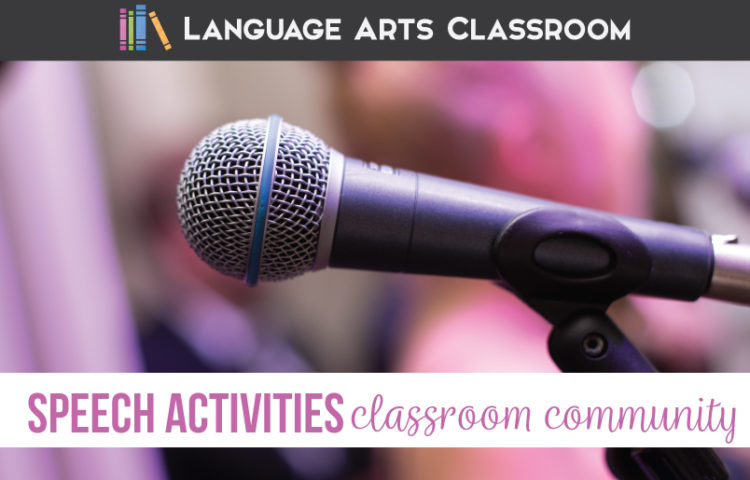Include public speaking lessons in your English lesson plans to help build classroom community.
Ah, public speaking. I believe speech has a firm place in ELA classes. I absolutely see speech class lessons as an opportunity to build my classroom community. Sometimes I feel like speech class lessons are pushed to the side, often like grammar lessons. It’s unfortunate because some students thrive with public speaking lessons. When students thrive, they contribute positively to building a classroom community.
Plus, I’m passionate about helping teenagers with public speaking because I struggled so much with it when I was in school.
Even in college (taking speech classes to become a speech teacher!), I faced sweaty hands, a sick stomach, and complete uncertainty. I teach public speaking with those experiences in mind; I know my students probably face the same obstacles.
Through teaching experiences, I’ve tweaked tricks for speech classes. Not only do these activities help public speaking students individually, but these speech class lessons also build a classroom community. Hopefully, these ideas will benefit your students too.
Outline Community Ideals
Building a community in every classroom is important; in a speech class, doing so is paramount to success. Students who fear their classmates will not want to speak and will not get valuable feedback. The nature of a speech class is that students learn about their audience and engage it.
To do so, build the community with small activities. I’ve written about public speaking activities before, but any will build comradeship.
Be honest with older students. No one wants to feel “less than” or uncomfortable. Develop guidelines for providing feedback; you might even brainstorm a list of potential constructive feedback pieces. Discuss what being a positive audience member means. Finally, enforce the guidelines. Students should see that you seriously expect kind interactions.
Model Partnership
To start speech class lessons, I often complete a quick partnership activity. Divide the class in half, or allow students to pick a partner. Take half the class in the hall—leaving partners behind. Explain that to the first group that you are charging them with noticing their partners’ hand gestures. Ask them to notice these gestures as the partner works in class, casually speaking. They should keep this information from the partner but be ready to share it in a week.
Tell the other half (the other half of the partners) that you are charging them with noticing their partners’ use of ‘fillers’ (those pesky words) like, um, uh, soooooo. (I have also asked both sets to monitor hand gestures. Both ways work equally well.) A few students will spoil what they are doing, but they still complete the activity. Overwhelmingly, students are invested in helping a classmate and do not spoil the activity.
In a week, ask students to share what they learned about their partners. Where does the partner keep his hands? By hips? Held down at sides? In front?
What word could the partner focus on eliminating? (Spoiler: normally, ‘like.’)
This information can comfort the student because every hand gesture seems unnatural while speaking! The speaker has a ‘go-to’ hand gesture though! My partner says I typically keep my hands at my sides. It might feel funny, but I believe I look ok.
Could the first partner help the speaker eliminate the filler?
Sometimes, public speakers need a pep talk, a realization that every public speaker has similar concerns. The partner helps with that.
The best part? You are teaching both sets of students lessons, and you are helping them invest in another student’s speech growth. The personal connection helps with empathy and provides an ally for each student.
Create Goals
In any of my public speaking lessons, students set goals for themselves. For students to be invested in improving themselves, they should decide their own goals for improvement. Often to build classroom community, I set aside time with any speaking lesson plan for students to brainstorm with each other for improvements. Doing so then allows for those students to work together on their goals.
Goal sheets, btw, also make grading speeches easier. Students ask me where to focus my feedback!

Where to start with speech lesson plans? Start with small, fun activities. Work on what students need practice with: tone, hand gestures, and confidence. Build community by working together. I know many teachers need some public speaking lessons, right now.
I’ve detailed six public speaking lessons and have them for free in my library. Sign-up below, and they will be yours!



